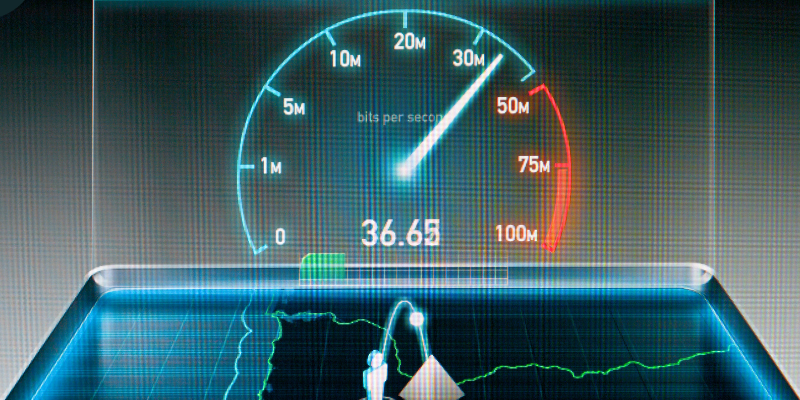Table of Contents
ToggleThe importance and the direct correlation between website speed and SEO cannot be overstated.
Understanding how these two elements interact becomes crucial for maintaining a competitive edge as more businesses pivot online.
A website that loads quickly enhances user satisfaction and significantly influences search engine rankings.
In this post, we will explore the myriad ways your website can improve visibility on Google and offer insights into optimizing its speed for better SEO performance.
The Connection Between Website Speed and User Experience
User experience (UX) is a cornerstone of a successful online presence, and website speed plays an integral role in shaping it.
When users visit a slow-loading site, their frustration often leads them to abandon the page, increasing bounce rates and diminishing engagement.

Research has consistently shown that even a one-second delay in page load time can lead to significant drops in user satisfaction and conversion rates.
Google’s algorithms are finely tuned to prioritize user experience, understanding that fast-loading sites keep users engaged longer and encourage them to explore more content.
This increased engagement signals to Google that the site is valuable, often resulting in better rankings.
A fast website enables a seamless experience, allowing users to swiftly navigate between pages, interact with content, and complete desired actions without unnecessary delays.
Website speed and SEO: A rapid site enhances trust and credibility.
Users are more likely to perceive a speedy website as professional and reliable, which can influence their likelihood to return.
This positive interaction is a key factor that Google considers when ranking sites.
Therefore, the symbiotic relationship between website speed and user experience is a critical element in achieving higher SEO rankings.
How Google Measures Website Speed
Google employs a suite of sophisticated tools and metrics to assess website speed, ensuring that it aligns with its stringent standards for optimal user experience.
These tools showcase the direct correlation between website speed and SEO.
One of the most recognized tools is Google PageSpeed Insights.
This tool evaluates both mobile and desktop versions of your site, offering detailed insights into various performance aspects such as loading time, interactivity, and visual stability.
To dig deeper, Google relies on Core Web Vitals—three pivotal metrics that encapsulate different facets of the user experience.
These metrics include:
- Largest Contentful Paint (LCP): It measures loading performance by identifying how quickly the main content of a page is rendered.
- First Input Delay (FID): Gauges interactivity by measuring the time it takes for a page to become responsive to user input.
- Cumulative Layout Shift (CLS): It assesses visual stability by tracking unexpected layout shifts during the page loading phase.
These Core Web Vitals are critical as they provide quantifiable data that helps Google determine the quality of the user experience your site delivers.
A website that excels in these metrics is often favored in search engine rankings.
Thus, understanding and optimizing for these specific metrics can make a significant difference in how your site performs on Google.
The Role of Mobile Optimization in Website Speed
With the surge in mobile device usage, optimizing your website for mobile speed is no longer optional—it’s imperative.
Google’s shift to mobile-first indexing underscores the importance of mobile optimization for both ranking and user experience.
A well-optimized mobile site should feature responsive design, streamlined content, and efficiently optimized images to ensure rapid load times.
Responsive design ensures that your site adapts to various screen sizes, providing a seamless experience regardless of the device being used.
Streamlined content, on the other hand, eliminates unnecessary elements that could bog down load times.
This includes minimizing redirects and avoiding large, cumbersome scripts that slow down performance.
Optimizing images for mobile devices involves reducing file sizes without compromising quality, which significantly contributes to faster loading speeds.
Failure to optimize for mobile speed can lead to higher bounce rates and a loss of potential customers who are unwilling to wait for slow pages to load.
Given that a significant portion of web traffic now comes from mobile devices, neglecting this aspect can severely impact your overall website performance and SEO rankings.
Ensuring that your mobile site loads quickly not only meets user expectations but also aligns with Google’s criteria for ranking, making it a vital component of your online strategy.
Technical Aspects That Influence Website Speed
Technical aspects play a pivotal role in determining website speed, directly impacting your site’s SEO performance.
Understanding these elements can help you make informed decisions to optimize your website for speed.
- Server Response Time: The duration it takes for a server to respond to a browser’s request can significantly affect loading times.
Opting for a high-quality hosting provider with robust infrastructure can ensure quicker server response times, thereby reducing delays.
- Image Optimization: Large, unoptimized images are often culprits of slow-loading websites.
Utilizing image compression techniques and modern formats like WebP can help maintain visual quality while reducing file sizes, leading to faster load times.
- Browser Caching: Caching stores copies of files on users’ browsers, eliminating the need to reload all resources upon subsequent visits.
Properly configured caching can dramatically enhance speed for returning users by reducing the load on your server and speeding up page rendering.
- Minification of CSS and JavaScript: Minifying involves stripping out unnecessary characters like spaces and comments from CSS and JavaScript files.
This process reduces file sizes, which speeds up download times and improves overall site performance.
- Content Delivery Network (CDN): A CDN distributes your website’s content across multiple servers located around the globe.
This geographic dispersion ensures that users access data from the nearest server, thereby reducing latency and speeding up load times.
- Efficient Code: Clean, efficient code not only makes your site more maintainable but also contributes to faster execution times.
Ensuring your website code is streamlined and free from redundancies can provide a noticeable boost to speed.
By focusing on these technical aspects, you can significantly improve your website’s load times, enhancing both user experience and SEO performance.

Case Studies on the Impact of Website Speed on SEO
Examining real-world case studies reveals the transformative connection between website speed and SEO rankings.
For instance, a leading e-commerce platform undertook a comprehensive overhaul to enhance its site’s load times.
By reducing the page load duration from 8 seconds to 3 seconds, they experienced a remarkable 25% surge in conversion rates.
Another compelling example comes from a popular SEO company in Miami, with a content-heavy website.
After implementing targeted speed optimization strategies—such as compressing images, leveraging browser caching, and minimizing HTTP requests—the site saw a significant uptick in user engagement metrics.
This included longer session durations, reduced bounce rates, and a higher volume of organic traffic.
These changes not only enriched the user experience but also elevated the site’s visibility on search engine results pages.
A third case involved a service-oriented business that invested in a CDN to reduce latency and improve content delivery.
The result was a 40% increase in page speed, which subsequently led to higher user retention rates and more favorable positions in search engine rankings.
These case studies underscore the importance of prioritizing website speed and its undeniable influence on enhancing SEO outcomes.
Each example illustrates how strategic optimizations can lead to measurable improvements in both user engagement and search engine visibility.
Tools and Resources for Measuring and Improving Website Speed and SEO
To effectively measure and enhance your website’s speed, leveraging the right tools can make all the difference.
- Google PageSpeed Insights: This is a go-to resource, offering a comprehensive analysis of your site’s performance on both desktop and mobile devices.
It provides actionable recommendations tailored to your website’s specific needs.
- GTmetrix: is another powerful tool that offers detailed reports on various performance metrics.
It evaluates your website against key speed indicators and highlights areas for improvement, giving you a roadmap for optimization.
- Pingdom: is particularly useful for monitoring website speed over time. It provides insights into your site’s loading time, performance grade, and areas that require attention.
Regularly using Pingdom can help you keep track of your site’s performance trends and identify issues before they impact user experience.
- WebPageTest: It offers a more specialized approach, and allows for advanced testing options.
This includes multi-step transactions, video capture, and content blocking, giving a deeper understanding of how different elements affect speed.
- Lighthouse: is an open-source, automated tool for improving the quality of web pages. It provides audits for performance, accessibility, SEO, and more, ensuring a holistic approach to site optimization.
Incorporating these tools into your website management routine will empower you to make informed decisions, leading to a faster, more efficient site that ranks better on Google.
Common Mistakes That Slow Down Your Website
When it comes to maintaining a fast-loading website, several common mistakes can inadvertently slow down your site, affecting both user experience and SEO performance.
First and foremost, not optimizing images is a frequent oversight that impacts your website speed and SEO.

Large image files can significantly hamper loading times, so it’s crucial to compress images without sacrificing quality.
Next, excessive use of plugins, especially on platforms like WordPress, can lead to bloated code and slower site performance.
It’s essential to audit and remove any unnecessary plugins to streamline your site’s functionality.
Another common pitfall is neglecting to leverage browser caching.
By not storing copies of your site’s files on users’ browsers, you force them to reload all resources on each visit, prolonging load times.
Poorly configured server settings can also be a hidden culprit.
An inadequately optimized server can dramatically affect how quickly your website responds to user requests.
Make sure your hosting provider is equipped to handle your site’s traffic efficiently.
Finally, overlooking the impact of unoptimized CSS and JavaScript files can also degrade your website’s speed.
Failing to minify these files—by removing unnecessary characters like spaces and comments—can result in longer load times.
Regularly review your site’s code and make the necessary adjustments to ensure a swift and seamless user experience.
The Business Benefits of a Faster Website
A faster website can be a game-changer for your business.
First and foremost, it enhances user experience, making visitors more likely to stay, engage, and convert.
Reduced bounce rates and longer session durations often translate into higher sales and better customer retention.
Moreover, a speedy site can significantly boost your brand’s reputation.
Users perceive fast-loading websites as more reliable and professional, fostering trust and encouraging repeat visits.
This elevated trust can differentiate you from competitors who may have sluggish sites, giving you an edge in the market.
Lastly, improved website speed can lead to better SEO performance. ( this holds to both national and local SEO )
Higher search engine rankings increase your visibility, driving more organic traffic to your business without the need for paid advertising.
Practical Steps to Speed Up Your Website Today
Speeding up your website doesn’t have to be an overwhelming task.
According to the top national SEO experts, with a few strategic adjustments, you can significantly enhance load times and improve your site’s overall performance.
Start by optimizing your images.
Utilize tools that compress image files without compromising quality, ensuring they load quickly.
Next, minimize HTTP requests by reducing the number of elements on each page.
Each element, whether it’s an image, script, or style sheet, requires a separate HTTP request, which can collectively slow down your site.
Leveraging browser caching is another effective tactic.
By storing copies of your site’s files in visitors’ browsers, you minimize the need for resources to be reloaded with each visit, which speeds up the user experience for returning visitors.
Choosing a reliable hosting provider is equally important.
Invest in a hosting service that offers robust performance and uptime guarantees, as a slow server can bottleneck even the most optimized website.
Consider using a Content Delivery Network (CDN) to distribute your site’s content across multiple servers worldwide.
A CDN ensures that users load data from the server closest to them, reducing latency and improving load times.
Additionally, regularly audit your website for unused plugins or extensions, which can bog down performance.
Streamline your site by removing any superfluous add-ons that aren’t serving a critical function.
Lastly, review your site’s code and ensure that it is clean and efficient.
Minify your CSS and JavaScript files to remove unnecessary characters and reduce file sizes, speeding up their download times.
By implementing these practical steps, you’ll not only enhance your website speed and SEO but also create a more engaging and satisfying user experience.

